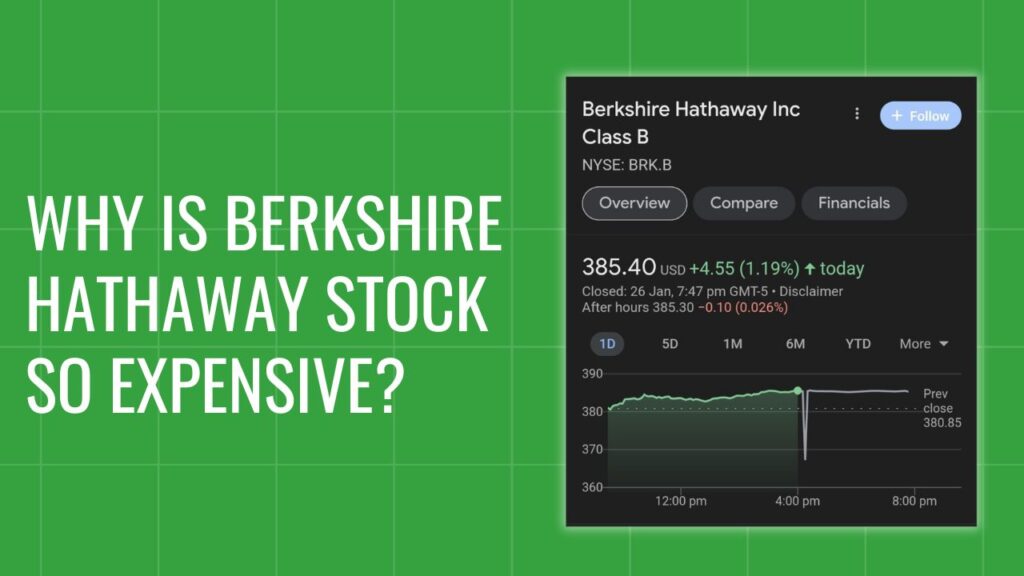
Berkshire Hathaway, the conglomerate led by legendary investor Warren Buffett, boasts a stock price that often leaves investors in awe. In this blog post, we’ll delve into the reasons behind the high cost of Berkshire Hathaway stock and explore the strategic decisions made by Buffett that contribute to its seemingly lofty valuation.
Understanding Relative Expensiveness
To comprehend why Berkshire Hathaway’s stock is considered expensive, it’s essential to recognize that the term “expensive” in the context of stocks is relative. Metrics like book value or cash flow play a crucial role in evaluating a stock’s worth. Berkshire Hathaway, over the years, has seen a significant surge in its stock price, creating an impression of relative expensiveness.
Historical Stock Price Journey
In 1980, a single share of Berkshire Hathaway could be acquired for less than $300. Fast forward to 2000, and the price had soared to an astonishing $50,000. Today, the stock price is over four times that amount, exemplifying an impressive journey in terms of valuation.
No Stock Split Strategy
A distinctive feature that sets Berkshire Hathaway apart from major companies like Microsoft, Apple, Amazon, and Google is its decision never to split its stock. This strategic move, spearheaded by Warren Buffett, serves a dual purpose. Firstly, it acts as a deterrent against short-term trading, discouraging investors seeking quick profits. Secondly, it serves as a catalyst to encourage a long-term investment mindset among shareholders.
Buffett's Perspective
Warren Buffett, often regarded as one of the most successful investors of our time, views shareholders as partners. His decision not to split the stock is a testament to his belief in cultivating a long-term relationship with investors. By maintaining a high stock price, Buffett ensures that buying and selling Berkshire shares becomes a significant decision, reinforcing his intention for shareholders to focus on the company’s long-term performance rather than short-term market fluctuations.
Introduction of Class B Shares
In 1996, Berkshire Hathaway introduced Class B shares (BRK.B), providing an alternative for investors who may not have significant capital. These Class B shares come at a lower price point, making them more accessible to a broader range of investors. This move aligns with Buffett’s vision of democratizing ownership in Berkshire Hathaway and allowing a diverse set of investors to participate in the company’s success.
Buffett's Intention Unveiled
The intentional maintenance of a high stock price serves as a cornerstone of Warren Buffett’s investment philosophy. The aim is to instill a sense of responsibility and careful consideration among shareholders when dealing with Berkshire shares. This strategy ensures that investors are more likely to focus on the long-term growth and prosperity of the company rather than being swayed by short-term market dynamics.
Conclusion
In unraveling the mystery behind the seemingly expensive Berkshire Hathaway stock, one discovers a carefully crafted strategy by Warren Buffett. The decision to forgo stock splits, coupled with the introduction of Class B shares, showcases Buffett’s commitment to fostering a shareholder base with a long-term perspective. As investors, understanding the rationale behind the high stock price allows us to appreciate the unique approach that has contributed to the enduring success of Berkshire Hathaway.
Frequently Asked Questions
The high cost is primarily due to Warren Buffett’s decision not to split the stock, aiming to discourage short-term trading and encourage a long-term investment mindset.
In 1980, a share cost less than $300. By 2000, it reached $50,000, and today, it is over four times that amount, showcasing substantial growth.
Warren Buffett has intentionally avoided stock splits to deter short-term trading and emphasize a focus on long-term investment among shareholders.
Buffett views shareholders as partners and aims to cultivate a long-term relationship. The high stock price reinforces this commitment.
The term “expensive” is relative to fundamental metrics like book value or cash flow, which play a crucial role in evaluating a stock’s worth.
Class B shares were introduced in 1996 to make Berkshire stock more accessible to a broader range of investors by offering a lower-priced alternative.
The high stock price makes buying and selling Berkshire shares significant decisions, aligning with Buffett’s intention for shareholders to focus on the long-term rather than short-term price fluctuations.
Buffett’s decision not to split the stock aligns with his vision of cultivating a shareholder base with a long-term perspective and fostering a sense of responsibility among investors.
No, Berkshire Hathaway has maintained a consistent strategy of not splitting its stock throughout its history.
The introduction of Class B shares provides an option for investors with smaller capital, making it more inclusive and aligning with Buffett’s goal of democratizing ownership in Berkshire Hathaway.
Read More: A Comprehensive Guide On How To Solve Money Problems
Check Finoven